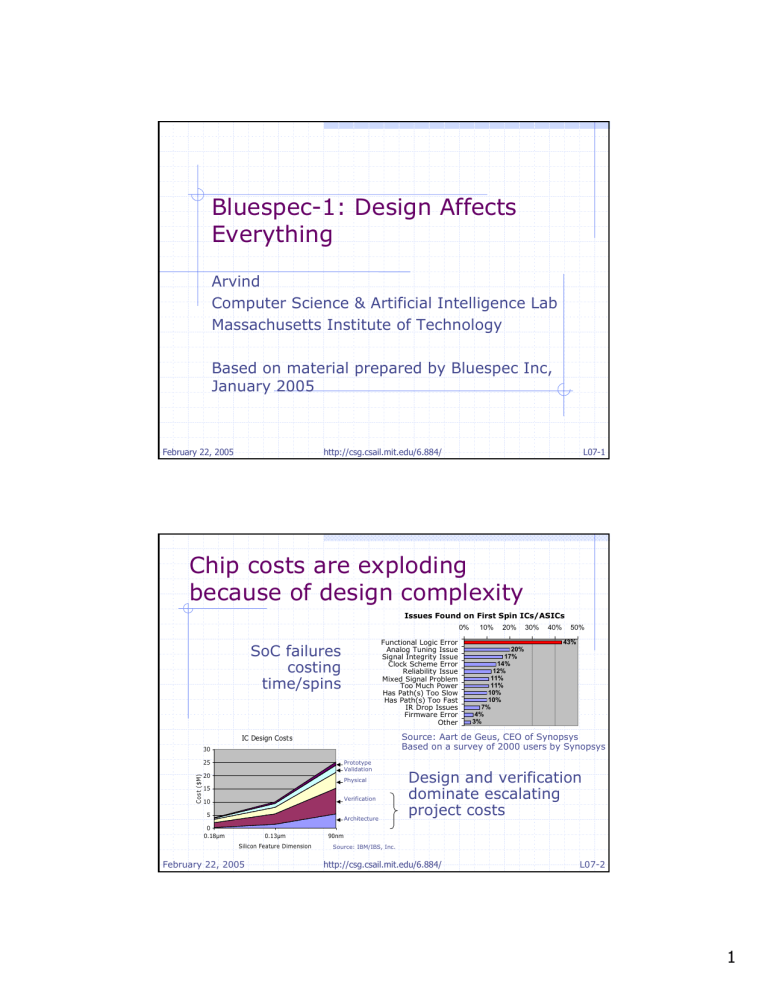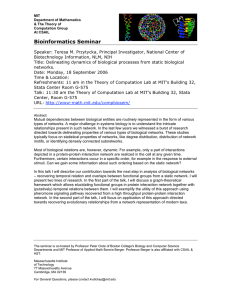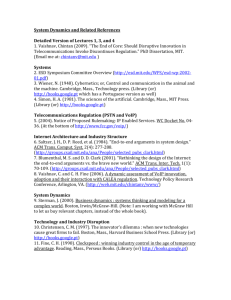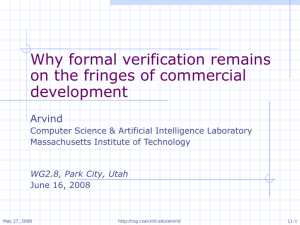Bluespec-1: Design Affects Everything
advertisement

Bluespec-1: Design Affects
Everything
Arvind
Computer Science & Artificial Intelligence Lab
Massachusetts Institute of Technology
Based on material prepared by Bluespec Inc,
January 2005
February 22, 2005
http://csg.csail.mit.edu/6.884/
L07-1
Chip costs are exploding
because of design complexity
Issues Found on First Spin ICs/ASICs
0%
Functional Logic Error
Analog Tuning Issue
Signal Integrity Issue
Clock Scheme Error
Reliability Issue
Mixed Signal Problem
Too Much Power
Has Path(s) Too Slow
Has Path(s) Too Fast
IR Drop Issues
Firmware Error
Other
SoC failures
costing
time/spins
Cost ($M)
25
Prototype
Validation
20
Physical
15
Verification
10
5
Architecture
0.13µm
Silicon Feature Dimension
February 22, 2005
20%
30%
40%
50%
43%
20%
17%
14%
12%
11%
11%
10%
10%
7%
4%
3%
wSource: Aart de Geus, CEO of Synopsys
wBased on a survey of 2000 users by Synopsys
IC Design Costs
30
0
0.18µm
10%
Design and verification
dominate escalating
project costs
90nm
wSource: IBM/IBS, Inc.
http://csg.csail.mit.edu/6.884/
L07-2
1
Common quotes
“Design is not a problem;
design is easy”
“Verification is a problem”
“Timing closure is a problem”
“Physical design is a problem”
nd
Mi
t
se
Almost complete reliance on post-design
verification for quality
February 22, 2005
L07-3
http://csg.csail.mit.edu/6.884/
Through the early 1980s:
The U.S. auto industry
Sought quality solely through post-build inspection
Planned for defects and rework
Make
Inspect
Rework
and U.S. quality was…
February 22, 2005
http://csg.csail.mit.edu/6.884/
Defect
De
fe
ct
Defect
L07-4
2
… less than world class
Image of Chevrolet Chevette removed due to copyright restrictions.
Adding quality inspectors (“verification
engineers”) and giving them better tools, was
not the solution
The Japanese auto industry showed the way
“Zero defect” manufacturing
February 22, 2005
http://csg.csail.mit.edu/6.884/
L07-5
New mind set:
Design affects everything!
A good design methodology
Can keep up with changing specs
Permits architectural exploration
Facilitates verification and debugging
Eases changes for timing closure
Eases changes for physical design
Promotes reuse
⇒ It is essential to
Design for Correctness
February 22, 2005
http://csg.csail.mit.edu/6.884/
L07-6
3
Why is traditional RTL
too low-level?
Examples with dynamic and
static constraints
February 22, 2005
L07-7
http://csg.csail.mit.edu/6.884/
Design must follow many
rules (“micro-protocols”)
Consider a FIFO (a queue)
first: examine item
at head of queue
enq: put an
item into the queue
deq: remove an
item from the queue
not empty
February 22, 2005
http://csg.csail.mit.edu/6.884/
deq
FIFO
first
In the hardware,
there are a number of requirements not empty ENAB
RDY
n
for correct use
DATA_OUT
enq
n
DATA_IN
ENAB
not full
RDY
RDY
L07-8
4
Requirements for correct use
Requirement 1: deq ENAB only when RDY (not empty)
Requirement 2: first DATA_OUT only when RDY (not empty)
Requirement 3: enq ENAB simultaneously with DATA_IN
Requirement 4: enq ENAB only when RDY (not full)
DATA_IN
ENAB
not empty
client
ENAB
RDY
n
DATA_OUT
RDY
not empty
February 22, 2005
deq
client
RDY
FIFO
first
not full
enq
n
client
L07-9
http://csg.csail.mit.edu/6.884/
Correct use of a shared FIFO
• Needs a multiplexer in front of each input ( )
• Needs proper control logic for the multiplexer
client 1
control
n
DATA_OUT
RDY
not empty
February 22, 2005
http://csg.csail.mit.edu/6.884/
deq
RDY
ENAB
not empty
RDY
FIFO
first
not full
client 2
enq
n
DATA_IN
ENAB
L07-10
5
Concurrent uses of a FIFO
enq ENAB ok if deq ENAB, even if not RDY ??
client 1
ENAB
RDY
client 2
n
DATA_OUT
RDY
not empty
February 22, 2005
deq
not empty
RDY
FIFO
first
not full
enq
n
DATA_IN
ENAB
http://csg.csail.mit.edu/6.884/
L07-11
Example from a commercially
available FIFO IP component
data_in
push_req_n
pop_req_n
clk
rstn
February 22, 2005
data_out
full
empty
These constraints are taken
from several paragraphs of
documentation, spread over
many pages, interspersed
with other text
http://csg.csail.mit.edu/6.884/
L07-12
6
A High-Bandwidth Credit-based
Communication Interface
Credit based interface:
I/F Control
Credit = C1
Module A
You can have X credits
I can send up to X items
I/F Control
Credit = C2
Module B
Static correctness constraints:
Data types agree on both ends?
Credit values agree (C1 == C2)?
Credit values automatically sized to comm latency?
B’s buffer properly sized (C2)?
B’s buffer pointers properly sized (log(C2))?
February 22, 2005
http://csg.csail.mit.edu/6.884/
L07-13
Why is Traditional RTL
low-level?
Hardware for dynamic constraints must
be designed explicitly
Design assumptions must be explicitly
verified
Design assumptions must be explicitly
maintained for future changes
If static constraints are not checked by
the compiler then they must also be
explicitly verified
February 22, 2005
http://csg.csail.mit.edu/6.884/
L07-14
7
In Bluespec SystemVerilog (BSV) …
Power to express complex static
structures and constraints
Checked by the compiler
“Micro-protocols” are managed by the
compiler
The compiler generates the necessary
hardware (muxing and control)
Micro-protocols need less or no verification
Easier to make changes while
preserving correctness
Î Smaller, simpler, clearer, more correct code
February 22, 2005
http://csg.csail.mit.edu/6.884/
L07-15
Bluespec SystemVerilog (BSV)
Bluespec SystemVerilog
High-level description of FSMs
Rules, Interface Methods
Static elaboration, verification
Types, Procedures
SystemVerilog
Structure
Modules, interfaces, types
HW semantics
Cooperating FSMs
+ Assertions
Structure
Modules, interfaces, types
HW semantics
Cooperating FSMs
+ Assertions
Low-level description of FSMs
Processes, cycle counting,
explicit management of
shared resources
Low-level description of FSMs
Processes, cycle counting,
explicit management of
shared resources
February 22, 2005
http://csg.csail.mit.edu/6.884/
L07-16
8
Bluespec Tool flow
Bluespec SystemVerilog source
Bluespec Compiler
Blueview
Verilog 95 RTL
C
Bluespec C sim
Cycle
Accurate
Verilog sim
VCD output
Legend
RTL synthesis
gates
Debussy
Visualization
files
Bluespec tools
3rd party tools
February 22, 2005
http://csg.csail.mit.edu/6.884/
L07-17
Bluespec: State and Rules
organized into modules
module
interface
All state (e.g., Registers, FIFOs, RAMs, ...) is explicit.
Behavior is expressed in terms of atomic actions on the state:
Rule: condition Î action
Rules can manipulate state in other modules only via their
interfaces.
February 22, 2005
http://csg.csail.mit.edu/6.884/
L07-18
9
Programming with
rules: A simple example
Euclid’s algorithm for computing the
Greatest Common Divisor (GCD):
15
9
3
6
3
0
February 22, 2005
answer:
6
6
6
3
3
3
subtract
subtract
swap
subtract
subtract
L07-19
http://csg.csail.mit.edu/6.884/
GCD in BSV
module mkGCD (ArithIO#(int));
Reg#(int) x <- mkRegU;
Reg#(int) y <- mkReg(0);
rule swap ((x > y) && (y != 0));
x <= y; y <= x;
endrule
rule subtract ((x <= y) && (y != 0));
y <= y – x;
endrule
State
Internal
behavior
method Action start(int a, int b) if (y==0);
x <= a; y <= b;
endmethod
method int result() if (y==0);
return x;
endmethod
endmodule
February 22, 2005
http://csg.csail.mit.edu/6.884/
External
interface
L07-20
10
enab
rdy
t
y == 0
rdy
GCD
module
implicit
conditions
y == 0
result
t
t
start
GCD Hardware Module
interface ArithIO #(type t);
method Action start (t a, t b);
method t result();
endinterface
Many different implementations can provide the same
interface:
module mkGCD (ArithIO#(int));
February 22, 2005
L07-21
http://csg.csail.mit.edu/6.884/
Generated Verilog RTL:
GCD
module mkGCD(CLK, RST_N,start__1, start__2, E_start_, ...)
input CLK; ...
output start__rdy; ...
wire [31 : 0] x$get; ...
assign result_ = x$get;
assign _d5 = y$get == 32'd0;
...
assign _d3 = x$get ^ 32'h80000000) <= (y$get ^ 32'h80000000);
assign C___2 = _d3 && !_d5;
...
assign x$set = E_start_ || P___1;
assign x$set_1 = P___1 ? y$get : start__1;
assign P___2 = _d3 && !_d5;
...
assign y$set_1 =
{32{P___2}} & y$get - x$get | {32{_dt1}} & x$get |
{32{_dt2}} & start__2;
RegUN #(32) i_x(.CLK(CLK), .RST_N(RST_N), .val(x$set_1), ...)
RegN #(32) i_y(.CLK(CLK), .RST_N(RST_N), .init(32'd0), ...)
endmodule
February 22, 2005
http://csg.csail.mit.edu/6.884/
L07-22
11
Exploring microarchitectures
IP Lookup Module
February 22, 2005
http://csg.csail.mit.edu/6.884/
L07-23
IP Lookup block in a router
LC
Line Card (LC)
Packet Processor
SRAM
(lookup table)
IP Lookup
Arbitration
Control
Processor
Switch
Queue
Manager
Exit functions
A packet is routed based on
the “Longest Prefix Match”
(LPM) of it’s IP address with
entries in a routing table
Line rate and the order of
arrival must be maintained
February 22, 2005
LC
LC
line rate ⇒ 15Mpps for 10GE
http://csg.csail.mit.edu/6.884/
L07-24
12
F
F
B
…
A
A
A
…
F
…
F
3
…
7
F
…
…
…
F
10.18.200.* C
C
7
F
F
5.*.*.*
E
*
F
IP address
Result
M Ref
F
2
10
255
10.18.201.5
F
3
7.14.7.2
A
4
5.13.7.2
E
10.18.200.7
C
1
4
February 22, 2005
18
200
5
D
…
10.18.200.5 D
7.13.7.3
14
A
…
E
…
5
F
…
B
F
…
7.14.7.3
0
…
A
…
7.14.*.*
…
Sparse tree representation
C
Real-world lookup algorithms
are more complex but all make
a sequence of dependent
memory references.
http://csg.csail.mit.edu/6.884/
L07-25
SW (“C”) version of LPM
int
lpm (IPA ipa)
{
int p;
/* 3 memory lookups */
p = RAM [ipa[31:16]];
if (isLeaf(p)) return p;
/* Level 1: 16 bits */
p = RAM [p + ipa [15:8]]; /* Level 2: 8 bits */
if (isLeaf(p)) return p;
}
p = RAM [p + ipa [7:0]]; /* Level 3: 8 bits */
return p;
/* must be a leaf */
How to implement LPM in HW?
Not obvious from C code!
February 22, 2005
http://csg.csail.mit.edu/6.884/
L07-26
13
Longest Prefix Match for IP lookup:
3 possible implementation architectures
Rigid pipeline
Linear pipeline
Inefficient memory
usage but simple
design
Efficient memory
usage through
memory port
replicator
Designer’s
Ranking:
1
2
Circular pipeline
Efficient memory
with most complex
control
Which is “best”?
3
Arvind,
Nikhil,
& Dave ICCAD 2004
February 22,
2005 Rosenbandhttp://csg.csail.mit.edu/6.884/
L07-27
Synthesis results
LPM
Code
size
(lines)
Best Area
(gates)
Best Speed
(ns)
Mem. util.
(random
workload)
Static V
220
2271
3.56
63.5%
Static BSV
179
2391 (5% larger)
3.32 (7% faster)
63.5%
Linear V
410
14759
4.7
99.9%
Linear BSV
168
15910 (8% larger)
4.7 (same)
99.9%
Circular V
364
8103
3.62
99.9%
Circular BSV
257
8170 (1% larger)
3.67 (2% slower)
99.9%
versions
Synthesis: TSMC 0.18 µm lib
- Bluespec results can match carefully coded Verilog
- Micro-architecture has a dramatic impact on performance
- Architecture differences are much more important than
language differences in determining QoR
V = Verilog;BSV
February
22, 2005
= Bluespechttp://csg.csail.mit.edu/6.884/
System Verilog
L07-28
14
Implementations of the same arch Static pipeline: Two designers, two results
LPM versions
Best Area
(gates)
Best Speed
(ns)
Static V (Replicated)
8898
3.60
Static V (BEST)
2271
3.56
IP addr
Replicated:
BEST:
result
IP addr
MUX
MUX / De-MUX
Each packet
is processed
by one FSM
FSM
Counter
February 22, 2005
FSM
FSM
result
FSM
MUX / De-MUX
RAM
http://csg.csail.mit.edu/6.884/
FSM
Shared
FSM
RAM
L07-29
Reorder Buffer
Verification-centric design
February 22, 2005
http://csg.csail.mit.edu/6.884/
L07-30
15
Example from CPU design
Register
File
Decode
Branch
FIFO
FIFO
ALU
Unit
FIFO FIFO
FIFO
FIFO
Fetch
ReOrder
Buffer
(ROB)
FIFO FIFO
Speculative, out-of-order
Many, many concurrent
activities
MEM
Unit
FIFO
Instruction
Memory
FIFO
Data
Memory
Nirav 22,
Dave,
February
2005MEMOCODE, 2004
http://csg.csail.mit.edu/6.884/
L07-31
ROB actions
Register
File
Get operands
for instr
Writeback
results
Re-Order Buffer
State Instruction Operand 1 Operand 2
Head
Decode
Unit
Insert an
instr into
ROB
Resolve
branches
February 22, 2005
Tail
Empty
Waiting
Dispatched
Killed
Done
E
W
Di
K
Do
Result
E
Instr
-
V
-
V
-
-
E
Instr
-
V
-
V
-
-
W
Instr
A
V
0
V
0
-
W
Instr
B
V
0
V
0
-
W
Instr
C
V
0
V
0
-
W
Instr
D
V
0
V
0
-
E
Instr
-
V
-
V
-
-
E
Instr
-
V
-
V
-
-
E
Instr
-
V
-
V
-
-
E
Instr
-
V
-
V
-
-
E
Instr
-
V
-
V
-
-
E
Instr
-
V
-
V
-
-
E
Instr
-
V
-
V
-
-
E
Instr
-
V
-
V
-
-
E
Instr
-
V
-
V
-
-
E
Instr
-
V
-
V
-
-
http://csg.csail.mit.edu/6.884/
Get a ready
ALU instr
Put ALU instr
results in ROB
Get a ready
MEM instr
Put MEM instr
results in ROB
ALU
Unit(s)
MEM
Unit(s)
L07-32
16
But, what about all
the potential race conditions?
Reading from the register file at the same
time a separate instruction is writing back to
the same location
Which value to read?
An instruction is being inserted into the ROB
simultaneously to a dependent upstream
instruction’s result coming back from an ALU
Put a tag or the value in the operand slot?
An instruction is being inserted into the ROB
simultaneously to A branch mis-prediction
must kill the mis-predicted instructions and
restore a “consistent state” across many
modules
February 22, 2005
L07-33
http://csg.csail.mit.edu/6.884/
Rule Atomicity
Lets you code each operation in isolation
Eliminates the nightmare of race conditions
(“inconsistent state”) under such complex
concurrency conditions
All behaviors are
Insert Instr in ROB
explainable as a
• Put instruction in first
sequence of atomic
available slot
actions on the
• Increment tailDispatch
pointer Instr
Mark instruction
• Get source •operands
state
dispatched Write Back Results to ROB
- RF <or> prev instr
• Forward to•appropriate
Write back results to
unit
instr result
Commit Instr
• Write back to all waiting
• Write results to register
tags
file (or allow memory
Branch Resolution
• Set to done write for store)
•…
• Set to Empty
•…
• Increment head pointer
•…
February 22, 2005
http://csg.csail.mit.edu/6.884/
L07-34
17
Synthesizable model of IA64
CMU-Intel collaboration
Develop an Itanium µarch model that is
concise and malleable
executable and synthesizable
FPGA Prototyping
XC2V6000 FPGA interfaced to P6 memory bus
Executes binaries natively against a real PC
environment (i.e., memory & I/O devices)
An evaluation vehicle for:
Functionality and performance: a fast µarchitecture
emulator to run real software
Implementation: a synthesizable description to
assess feasibility, design complexity and
implementation cost
Roland Wunderlich & James Hoe @ CMU
Steve Hynal(SCL) & Shih-Lien Liu(MRL)
February 22, 2005
L07-35
http://csg.csail.mit.edu/6.884/
IA64 in Bluespec
Wunderlich & Hoe
IPF Microarchitecture Model
Pipe. Control
Branch
Stack
Read
Integer×3
Fetch
Execute
Write
Bypass
Branch Pred.
Decode
Stack
Read
Execute
Read
Execute
Write
Disperse
Stack
Register Set
Instr. Cache
Memory
FSB Control
Unified L2
Stack
Memory
Write
Roland Wunderlich
3
Data Cache
Platform Capabilities
Roland Wunderlich
5
The model was developed in a
few months by one student!
High speed execution of the Bluespec model,
runs at 100 MHz, 4 orders of magnitude faster
than ModelSim
Full access to the FSB, allowing 800 MB/s cache
line reads and writes, plus a control channel to
the Pentium III processor via mapped I/O
Large FPGA resources, the current design
occupies less than 30% of the FPGA resources
Roland Wunderlich
February 22, 2005
http://csg.csail.mit.edu/6.884/
7
L07-36
18


